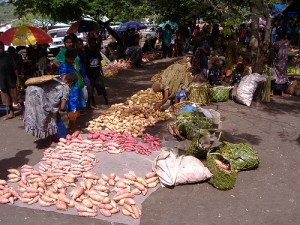- Banana going extinct. Again.
- Pigs are good weedkillers.
- Bee bailout in the UK.
- India has an agricultural Wikipedia. With a blog. Via.
- Do you know this cat?
- SEED 2009 Awards for entrepreneurs. Found at the LEISA blog.
- TED talk on building better wines through genomics.
Fighting osteoporosis with lettuce
Researchers have apparently engineered lettuce to express higher levels of the sCAX1 gene which pumps calcium into the cell’s vacuole, leading to 25-32% higher levels of the nutrient in the leaves. Sadly, there’s nothing in the article about genetic variation in Ca content among different varieties, so it’s not clear whether these increases could have been achieved by conventional breeding. Anyway, despite the paper, which I nibbled yesterday, showing the possibility of a link between Ca content and bitterness, there was apparently no difference in bitterness between the normal and biofortified lettuces. So that’s allright then.
Bananas on the radio
Voice of America has five (count them!) articles and podcasts on the banana in Africa. Going to take me a while to get through the whole lot, but I’ll try to post a summary when I do.
Sweet potato diversity identified
Amazingly, there are people out there who can name a sweet potato variety at twenty paces. And in a photograph. Check out the comments to a recent flickr upload of mine showing a market in Rabaul. Now, if only I had geo-referenced it…

Nibbles: Spices, Tequila, Tea, Potatoes, Archive, Africa, Carotenoids, Calcium, AGR, Ethiopia, Wheat blast
- Where do spices come from, mummy?
- Even “good” tequila can be bad for you. Well I never.
- Sparkling tea? Call it a microwine. Via.
- More potatoes. …
- … but the kicker is the historical archive she links to.
- AGRA and Earth Institute to collaborate. Africa not available for comment.
- More Pacific food crop nutrition goodness from Lois et al.
- Children may not like their veggies because of the Ca content.
- Canada down to 95% Holsteins. Oh dear.
- “The large crop genetic diversity that already exists in Ethiopia will make adapting agricultural systems to the locally changing conditions relatively easy.” Well, maybe…
- Screening Kansas wheat varieties for resistance to wheat blast.